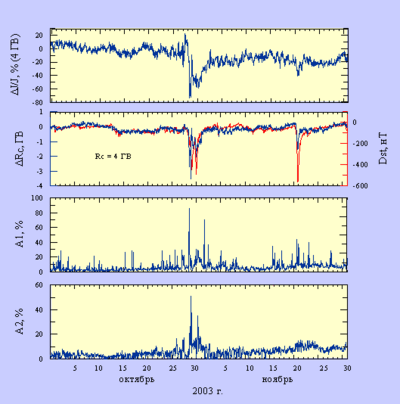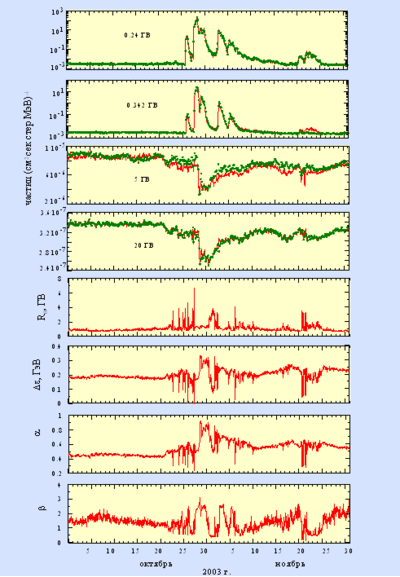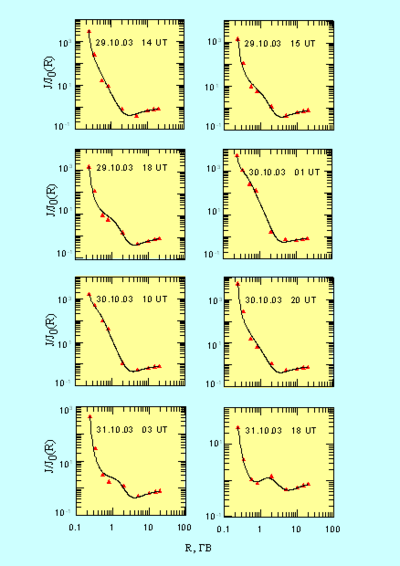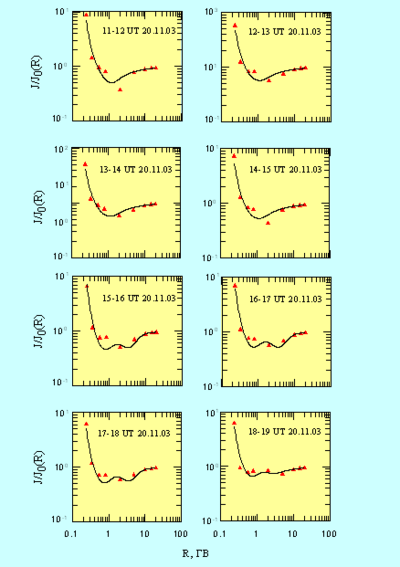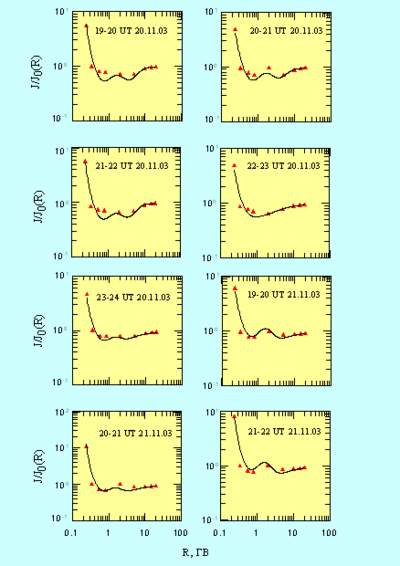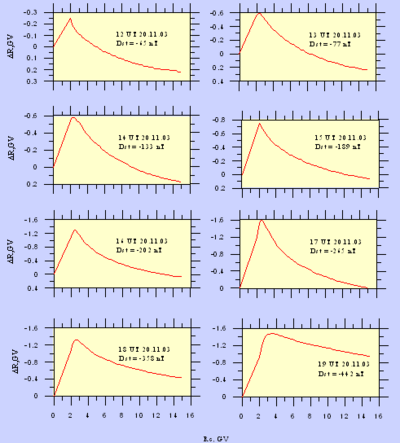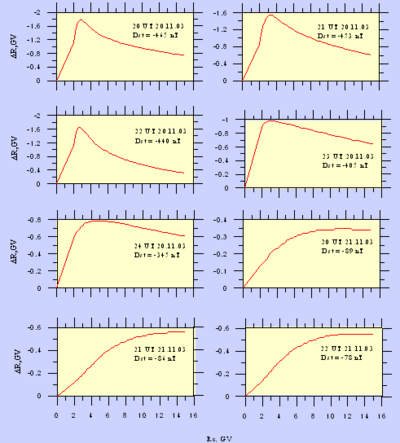Institute of Solar-Terrestrial Physics of Siberian Branch of Russian Academy of Sciences (ISTP SB RAS)
Variations in cosmic-ray intensity during extreme solar-heliospheric events in October-November 2003
From ISTP SB RAS
Variations of cosmic ray (CR) intensity were investigated using ground-based and satellite measurements in the energy range from ~15 MeV to tens of GeV over a period of 1 October – 30 November 2003. Information on solar sources and interplanetary medium parameters is placed on http://solarwind.cosmos.ru/materials.htm.
Analysis was based on the GOES-10 data about proton intensity over the energy range of 15-44, 39-82, 84-200, and 110-500 MeV as well as on data about variations in intensity of CR with different rigidity; the latter were obtained using the method of spectrographic global survey (SGS) [1-4] from ground-based measurements at the world neutron monitor network (38 stations). The SGS method allows us to obtain information about variations in angular and energy distribution of primary CR beyond the Earth’s magnetosphere, using ground-based CR measurements at the world network. Data about variations in the planetary system of geomagnetic cutoff rigidity per observation hour are also available due to the SGS method. Amplitude variations were calculated about the mean value (12 October 2003).
In order to describe the CR rigidity spectrum over a wide energy range, we used the expression obtained on the assumption that rigidity spectrum in the Galaxy is described by a power function of the CR rigidity, and variation of their intensity in interplanetary space is caused by energy changes in heliospheric regular electromagnetic fields according to the Liouville theory (i.e., subject to the constancy of the particle density along the mechanical trajectory ). In this case the differential rigidity spectrum takes the form:
where e is the total particle energy, e0 is the rest energy, T0 is the kinetic energy (such that the CR intensity of a definite rigidity in the Galaxy equals to A), De is the variation of particle energy in the heliosphere, determined by the expression [5]:
Here ![]() ( (Ze is the particle charge, U is the potential of the heliospheric induced electric field
( (Ze is the particle charge, U is the potential of the heliospheric induced electric field ![]() , с is the velocity of speed, W is the angular solar-rotation velocity, Br(r0) is the intensity of radial component of interplanetary magnetic field (IMF) at the distance r0 away from the Sun, u is the solar wind velocity (SW), B is the IMF intensity),
, с is the velocity of speed, W is the angular solar-rotation velocity, Br(r0) is the intensity of radial component of interplanetary magnetic field (IMF) at the distance r0 away from the Sun, u is the solar wind velocity (SW), B is the IMF intensity),
![]() , B0 is the background IMF intensity, B is the time-variable IMF intensity
, B0 is the background IMF intensity, B is the time-variable IMF intensity ![]() , Epl is the intensity of polarization electric field appearing in the heliosphere due to propagation of accelerated particle fluxes, R0 is the magnetic rigidity of particles whose Larmor radius equals to sizes of regions with non-stationary electromagnetic fields. Unknown parameters Dept, a, b, and R0 of rigidity spectrum were determined with ground-based and satellite observation data, using average hourly values of intensity.
, Epl is the intensity of polarization electric field appearing in the heliosphere due to propagation of accelerated particle fluxes, R0 is the magnetic rigidity of particles whose Larmor radius equals to sizes of regions with non-stationary electromagnetic fields. Unknown parameters Dept, a, b, and R0 of rigidity spectrum were determined with ground-based and satellite observation data, using average hourly values of intensity.
When describing the CR anisotropy, we used assumption about dependence of intensity of particles on their pitch angle in IMF; we also took account of anisotropy components dependent on the density gradient on the Larmor radius (Hall components). In order to approximate dependence of the CR intensity on pitch angle in IMF, we used sequence of Legendre polynomials (up to the second harmonics exclusive); in order to take Hall components of anisotropy into account, we used the first spherical harmonics, provided that this component is orthogonal to the IMF vector.
Contents |
[edit] Analysis results
1. Variations of CR global intensity (rigidity R is 4 GV) outside the magnetosphere in percentage to the background level; variations of geomagnetic cutoff rigidity at R=4 GV and Dst index (red curve) (the second panel from the top); time variations in amplitudes of the first A1 and second A2 harmonics characterizing the CR anisotropy (two lower panels) in October–November 2003.
2. Time profiles of CR intensity with rigidities R=0.24 GV (15–44 MeV), R=0.342 GV (39-82 MeV), R=5 и 20 GV (four top panels) computed from formulas (1) and (2) using parameters Dept, a, b. R0 (four bottom panels) obtained from ground-based and satellite measurements in October–November 2003. Red curves on four top panels are calculation results; points are observations.
3-а. Rigidity spectra of relative CR-intensity variations at some moments of the time interval from 26 to 29 October 2003. Black curves are results of model spectrum calculations with formulas (1) and (2); triangles are observations.
3-b. Rigidity spectra of relative CR-intensity variations at some moments of the time interval from 29 to 31 October 2003. Black curves are results of model spectrum calculations with formulas (1) and (2); triangles are observations.
4-а. Rigidity spectra of relative CR-intensity variations at some moments of 20 November 2003. Black curves are results of model spectrum calculations with formulas (1) and (2); triangles are observations.
4-b. Rigidity spectra of relative CR-intensity variations at some moments of 20 and 21 November 2003. Black curves are results of model spectrum calculations with formulas (1) and (2); triangles are observations.
5-а. Variations in geomagnetic cutoff rigidities DRc depending on threshold rigidities Rc at some moments from 29 to 30 October 2003.
5-b. Variations in geomagnetic cutoff rigidities DRc depending on threshold rigidities Rc at some moments from 30 to 31 October 2003.
6-а. Variations in geomagnetic cutoff rigidities DRc depending on threshold rigidities Rc at some moments of 20 November 2003.
6-b. Variations in geomagnetic cutoff rigidities DRc depending on threshold rigidities Rc at some moments on 20 and 21 November 2003.
[edit] Conclusoins
1. The expression in use for the differential rigidity CR spectrum describes adequately proton intensity variations in the energy range from ~ 15 MeV to tens of GeV throughout the period under study (see Fig. 2–4).
2. CR intensity variations (as part of the model employed) can be caused first by time variations and spatial inhomogeneity of the induced electric field potential; second by particle acceleration in loop-like structures of coronal and interplanetary time-variant magnetic fields; and third by background particle acceleration through polarization electric fields resulting from propagation of particles, accelerated in the solar corona and interplanetary space, in inhomogeneous fields of the heliosphere.
In this case due to time variations the magnetic field strength in these structures changes 2–3 times relative to the background one (see behaviour of parameter b in Fig. 2), and the squared ratio of the polarization electric field strength to the magnetic one varies within ~ 0 and ~ 0.9 (see behaviour of parameter a in Fig. 2). Sizes of areas with non-stationary electromagnetic fields (recalculated for the Earth’s orbit) according to R0 parameter values (see Fig. 2) are 1010–1011 cm. The induced electric field potential value decreased almost to zero values and increased ~1.5 times about background values (see Fig. 2).
3. At some moments of the studied interval, one can see a bidirectional anisotropy of large amplitude (tens of percent) in angular particle distribution that points first to carrying out of magnetic clouds and loop-like structures of the interplanetary magnetic field (IMF) by coronal mass ejections and second to a high degree of IMF regularity in these structures [4, 6]. Maximum amplitudes of the bidirectional anisotropy were observed on 29 and 31 October (~ 50 % and 30 % respectively) and for particles with R=4 GV on 21–24 November (~ 15 %) (see Fig. 1).
4. Maximum variations of geomagnetic cutoff rigidities were seen during geomagnetic storms within the threshold rigidity interval from 2 to 5 GV on 29–30 October and 20 November 2003 (see Fig. 1, 5, 6).
[edit] References
1. Dvornikov V.M., Sdobnov V.E., Sergeev A.V. Analysis of cosmic ray pitch-angle anisotropy during the forbush-effect in June 1972 by the method of spectrographic global survey // Proc. 18th ICRC. Bangalor. India. 1983. V. 3. P. 249-252.
2. Дворников В.М., Сдобнов В.Е. Модификация метода спектрографической глобальной съемки для изучения вариаций планетарной системы жесткостей геомагнитного обрезания // Изв. АН СССР. Сер. физ. 1991. T. 55, © 10. С. 1988-1991.
3. Dvornikov V.M., Sdobnov V.E. Time variations of the cosmic ray distribution function during a solar proton event of September 29, 1989 // J. Geophys. Res. 1997. V. 102, N A11. P. 24209-24219.
4. Dvornikov V.M., Sdobnov V.E. Variations in the rigidity spectrum and anisotropy cosmic rays at the period of Forbush effect on the 12-25 July 1982 // IJGA. 2002. V. 3, N 3. P. 217-228.
5. Дворников В.М., Сдобнов В.Е., Юдина М.В. Механизм модуляции космических лучей регулярными электромагнитными полями гелиосферы // Астрон. вестник. 2004 (в печати).
6. Richardson I.G., Dvornikov V.M., Sdobnov V.E., Cane H.V. Bidirectional particle flows at cosmic ray and lower (~1 MeV) energies, and their association with interplanetary CMEs/ejecta // J. Geophys. Res. 2000. V. 105, N A6. P. 12579-12591.
[edit] Authors
The presented results were obtained by authors:
- Dvornikov V.М., ISTP SB RAS (dvornikov@iszf.irk.ru)
- Sdobnov V.Е., ISTP SB RAS (sdobnov@iszf.irk.ru)
- Yudina М.V., ISTP SB RAS (rina@iszf.irk.ru)
- Belov А.V., IZMIRAN (abelov@izmiran.rssi.ru)
- Eroshenko Е.А., IZMIRAN (erosh@izmiran.rssi.ru)
- Yanke V.G., IZMIRAN (yanke@izmiran.rssi.ru)
- Kryakunova О.N., Institute of Ionosphere, Kazakhstan (krolganik@yandex.ru)
- This page has been accessed 3,686 times.


